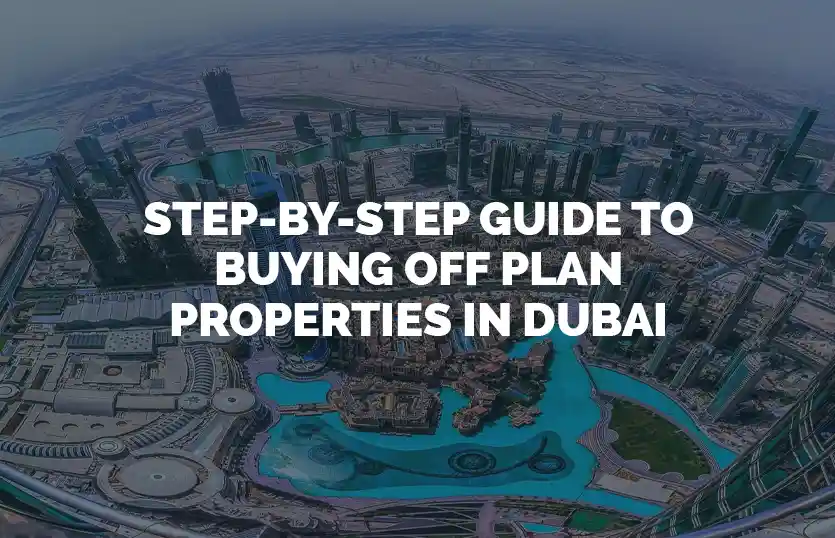
Step by Step Guide to Buying Off Plan Properties in Dubai
Dubai’s real estate market continues to attract global investors, and off-plan properties remain a popular choice for those looking to secure high returns. But how do you navigate the process of buying off-plan property in Dubai? This guide breaks it down into simple, actionable steps to help you make informed decisions.
What Are Off-Plan Properties?
Off-plan properties are real estate units that are sold before they are fully constructed. Buyers purchase these properties based on architectural plans, designs, and the promise of future value. In Dubai, off-plan properties often come with flexible payment plans, making them an attractive option for investors and end-users alike.
Why Buy Off-Plan Properties in Dubai?
- Lower Entry Costs: Developers often offer attractive payment plans, requiring only a small upfront deposit.
- High ROI Potential: Properties are typically sold at lower prices during the pre-construction phase, allowing for significant capital appreciation.
- Customization Options: Buyers can often choose finishes and layouts during the early stages of construction.
- Tax-Free Returns: Dubai’s tax-free environment makes it a lucrative market for property investors.
Step-by-Step Guide to Buying Off-Plan Properties in Dubai
1. Research the Market
Start by understanding Dubai’s real estate market trends. Look for areas with high growth potential, such as Dubai Marina, Downtown Dubai, or Palm Jumeirah. Use reliable sources like property portals, developer websites, and market reports to gather data.
2. Set a Budget
Determine how much you can afford to invest. Consider not only the property price but also additional costs like registration fees, agent commissions, and service charges.
3. Choose a Reputable Developer
The developer’s reputation is crucial when buying off-plan. Look for developers with a proven track record of delivering projects on time and to high standards. Some well-known developers in Dubai include Emaar, Nakheel, and DAMAC.
4. Review Payment Plans
Off-plan properties often come with flexible payment plans, such as:
- Post-Handover Payment Plans: Pay a percentage during construction and the rest after handover.
- Installment Plans: Spread payments over several years.
5. Understand the Legal Framework
Dubai has strict regulations to protect buyers of off-plan properties. Ensure the project is registered with the Dubai Land Department (DLD) and that the developer has obtained all necessary permits.
6. Visit the Sales Center
Once you’ve shortlisted a property, visit the developer’s sales center to view the show unit, floor plans, and project details. This will give you a clearer idea of what to expect.
7. Reserve Your Unit
If you’re satisfied with the property, reserve your unit by paying a booking fee (usually 5-10% of the property price). This secures the unit while you finalize the paperwork.
8. Sign the Sales Agreement
The sales agreement, also known as the Memorandum of Understanding (MoU), outlines the terms of the purchase, including payment schedules, completion dates, and penalties for delays.
9. Register the Property
Once the sales agreement is signed, register the property with the Dubai Land Department. This involves paying a registration fee (4% of the property value) and obtaining an Oqood (initial contract).
10. Monitor Construction Progress
Stay updated on the construction progress by visiting the site or requesting updates from the developer. This helps ensure the project is on track.
11. Prepare for Handover
Once the property is completed, the developer will notify you for the final inspection and handover. During this stage, you’ll need to:
- Pay any remaining dues.
- Conduct a snagging inspection to identify defects.
- Obtain the title deed.
12. Plan for Ownership
After handover, you can choose to live in the property, rent it out, or sell it. If you plan to rent, consider hiring a property management company to handle tenant relations and maintenance.
Common Pitfalls to Avoid
- Overlooking Hidden Costs: Factor in service charges, maintenance fees, and utility connections.
- Ignoring Market Trends: Avoid buying in oversupplied areas where prices may stagnate.
- Skipping Legal Checks: Always verify the developer’s credentials and project approvals.
- Rushing the Decision: Take your time to research and compare options before committing.
Buying off-plan property in Dubai can be a rewarding investment if done correctly. By following this step-by-step guide, you can minimize risks and make informed decisions. Whether you’re a first-time buyer or a seasoned investor, Dubai’s real estate market offers endless opportunities for growth. Eplogoffplan helps you navigate the process with expert insights and exclusive property options.
